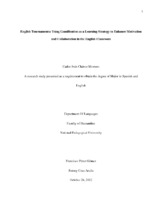Mostrar el registro sencillo del ítem
English tournaments : using gamification as a learning strategy to enhance motivation and collaboration in the English Classroom.
| dc.contributor.advisor | Cruz Arcila, Ferney | spa |
| dc.contributor.author | Chávez Montero, Carlos Iván | spa |
| dc.coverage.spatial | Bogotá, Colombia | spa |
| dc.coverage.temporal | Bogotá, Colombia 2022 | spa |
| dc.date.accessioned | 2023-01-23T21:13:32Z | |
| dc.date.available | 2023-01-23T21:13:32Z | |
| dc.date.issued | 2022 | |
| dc.identifier.uri | http://hdl.handle.net/20.500.12209/17925 | |
| dc.description.abstract | Gamification is a strategy that applies principles of games in contexts that are not necessarily related to gaming activities, such as business, corporations, and formal education. Those principles consist primarily of the establishment of a set of rules, common objectives, and the delivery of rewards (Sailer et al., 2017). In this context, the use of gamification in the English classroom offers a rethink of the class and curricula structure. The use of distinctive elements, i.e., leaderboards, teamwork, and scoring systems instead of the more usual classwork and assessment techniques can enhance the motivation of learners (Baranek, 1996). This study stems from the implementation of a pedagogical intervention, which consisted of a series of English tournaments that faced students with tasks based on collaborative learning and gamification. The tournaments were a way to apply gamification to each class session, merging games and academic activities related to the English curriculum of tenth-grade students at the I.E.D Sorrento, articulated with the English class contents. An alternative class environment was offered, creating a space in which the students grouped with their peers and got involved into their process, making them interested and motivated to learn and practice English. | spa |
| dc.format.mimetype | application/pdf | spa |
| dc.language.iso | eng | |
| dc.publisher | Universidad Pedagógica Nacional | spa |
| dc.rights.uri | https://creativecommons.org/licenses/by-nc-nd/4.0/ | |
| dc.subject | Gamification | eng |
| dc.subject | Motivation | eng |
| dc.subject | English learning | eng |
| dc.subject | Collaborative learning | eng |
| dc.title | English tournaments : using gamification as a learning strategy to enhance motivation and collaboration in the English Classroom. | eng |
| dc.publisher.program | Licenciatura en Español e Inglés | spa |
| dc.type.hasVersion | info:eu-repo/semantics/acceptedVersion | |
| dc.rights.accessrights | info:eu-repo/semantics/openAccess | |
| dc.rights.accessrights | http://purl.org/coar/access_right/c_abf2 | |
| dc.relation.references | Baranek, L. K. (1996). The Effect of Rewards and Motivation on Student Achievement. Master Thesis, 285. http://scholarworks.gvsu.edu/theses%0Ahttp://scholarworks.gvsu.edu/theses/285 | |
| dc.relation.references | Braun, V., & Clarke, V. (2012). Thematic analysis. APA Handbook of Research Methods in Psychology, Vol 2: Research Designs: Quantitative, Qualitative, Neuropsychological, and Biological., 57–71. https://doi.org/10.1037/13620-004 | |
| dc.relation.references | Burns, A. (2015). Action Research. Research Methods in Applied Linguistics, 187–202. Figueroa-Flores, Jorge. (2015). Using Gamification to Enhance Second Language Learning. Digital Education Review. 27. 32-54. | |
| dc.relation.references | Gnambs, T., & Hanfstingl, B. (2015). The decline of academic motivation during adolescence: an accelerated longitudinal cohort analysis on the effect of psychological need satisfaction. Educational Psychology, 36(9), 1691–1705. https://doi.org/10.1080/01443410.2015.1113236 | |
| dc.relation.references | Gottfried, A. E., Fleming, J. S., & Gottfried, A. W. (2001). Continuity of academic intrinsic motivation from childhood through late adolescence: A longitudinal study. Journal of Educational Psychology, 93 (1), 3–13. https://doi.org/10.1037/0022-0663.93.1.3 | |
| dc.relation.references | Hanus, M. D., & Fox, J. (2015). Assessing the effects of gamification in the classroom: A longitudinal study on intrinsic motivation, social comparison, satisfaction, effort, and academic performance. Computers & Education, 80, 152–161. https://doi.org/10.1016/j.compedu.2014.08.019 | |
| dc.relation.references | Huang, W. H.-Y., & Soman, D. (2013). A practitioner’s guide to gamification of education. Toronto: University of Toronto, Rotman School of Management. | |
| dc.relation.references | Kiryakova, G., Angelova, N., & Yordanova, L. (2013). Gamification in education. Proceedings of 9th International Balkan Education and Science Conference. | |
| dc.relation.references | Laal, M., & Ghodsi, S. M. (2012). Benefits of collaborative learning. Procedia - Social and Behavioral Sciences, 31(2011), 486–490. https://doi.org/10.1016/j.sbspro.2011.12.091 | |
| dc.relation.references | Malterud, K. (2001). Qualitative research: standards, challenges, and guidelines. The Lancet, 358(9280), 483–488. https://doi.org/10.1016/s0140-6736(01)05627-6 | |
| dc.relation.references | Marczewski, A. (2013). Gamification: A Simple Introduction. Andrzej Marczewski. | |
| dc.relation.references | Ministerio de Educación Nacional (2016). Derechos Básicos de Aprendizaje: Inglés grados 6° a 11°. | |
| dc.relation.references | Rehman, A. A., & Alharthi, K. (2016). An Introduction to Research Paradigms. International Journal of Educational Investigations, 3(8), 51–59. https://www.researchgate.net/publication/325022648_An_introduction_to_research_paradigms | |
| dc.relation.references | Sailer, M., Hense, J. U., Mayr, S. K., & Mandl, H. (2017). How gamification motivates: An experimental study of the effects of specific game design elements on psychological need satisfaction. Computers in Human Behavior, 69, 371–380. https://doi.org/10.1016/j.chb.2016.12.033 | |
| dc.publisher.faculty | Facultad de Humanidades | spa |
| dc.type.local | Tesis/Trabajo de grado - Monografía - Pregrado | spa |
| dc.type.coar | http://purl.org/coar/resource_type/c_7a1f | eng |
| dc.description.degreename | Licenciado en Español e Inglés | spa |
| dc.description.degreelevel | Pregrado | spa |
| dc.type.driver | info:eu-repo/semantics/bachelorThesis | eng |
| dc.identifier.instname | instname:Universidad Pedagógica Nacional | spa |
| dc.identifier.reponame | reponame: Repositorio Institucional UPN | spa |
| dc.identifier.repourl | repourl: http://repositorio.pedagogica.edu.co/ | |
| dc.rights.creativecommons | Attribution-NonCommercial-NoDerivatives 4.0 International |

